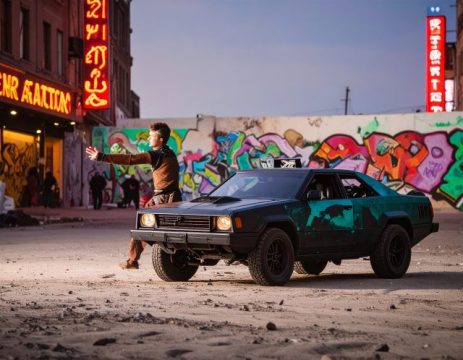Mention the name Grand Theft Auto, and you’ll likely get a strong reaction. For over two decades, Rockstar Games’ monumental franchise has been synonymous with blockbuster sales, critical acclaim, and headline-grabbing controversy. But to see GTA as just a video game is to miss the bigger picture. Its sprawling, satirical worlds and unparalleled sense of freedom have created a cultural phenomenon whose shockwaves are felt far beyond your gaming console.
From revolutionizing open-world design to shaping the sound of modern radio and becoming a masterclass in social commentary, GTA‘s legacy is woven into the very fabric of pop culture. It has influenced filmmakers, inspired musicians, and offered a funhouse mirror to American society that is as hilarious as it is scathing. So, buckle up and tune the radio to your favorite station as we explore the 10 definitive ways Grand Theft Auto has influenced pop culture.
10. Becoming a Digital Hangout Space
Beyond missions and mayhem, Grand Theft Auto Online—the multiplayer component of GTA V—has evolved into far more than just a game. It became a digital hangout space where players connect, unwind, and socialize in a virtual world. Millions log in daily not just to complete high-stakes heists or competitive challenges, but to simply cruise the city, customize vehicles, host parties in luxury apartments, or even role-play as civilians and police officers.
This open-ended, player-driven interaction helped redefine what a modern online game could be. GTA Online blurred the lines between entertainment and social networking, paving the way for other virtual platforms to embrace similar features. Its success also inspired developers to explore shared online experiences and contributed to the growing conversation around the “metaverse.”
By transforming a chaotic crime simulator into a global social hub, GTA showcased the potential of video games as dynamic, communal environments where digital lives unfold in real time.
9. Creating a Modding Subculture
Grand Theft Auto has been instrumental in building one of the most passionate and creative modding communities in gaming history. From early titles like GTA III to the expansive world of GTA V, fans have continuously developed custom mods that add new characters, vehicles, missions, graphics enhancements, and even entire gameplay overhauls.
This grassroots movement has turned the GTA series into a living sandbox that constantly evolves—long after official updates end. Some mods have gone viral, such as superhero crossovers, ultra-realistic police roleplay, or photorealistic graphic upgrades. Others, like FiveM, have transformed GTA Online into a full-fledged roleplaying platform, spawning dedicated servers where players take on jobs as police officers, criminals, taxi drivers, and more.
By empowering players to reshape the game world, GTA helped normalize modding as a core part of modern gaming culture. This community-driven innovation has inspired other developers to support modding tools and celebrate user-generated content.
8. Inspiring Music Videos and Film Aesthetics
Grand Theft Auto has had a noticeable influence on music videos, short films, and broader visual aesthetics across pop culture. Its gritty, urban environments, neon-soaked streets, and cinematic camera angles have inspired countless creatives to mimic the GTA look in their own work. From stylized rap videos to indie film projects, the series’ visual identity has become instantly recognizable and culturally influential.
Many music artists have directly referenced GTA in their lyrics or music videos, recreating scenes with fast cars, gang dynamics, or character perspectives that mirror the game’s signature third-person view. Some even use GTA V‘s in-game engine to produce animated music videos, giving fans a fully immersive digital experience.
This crossover between gaming and visual storytelling has contributed to a new kind of aesthetic language—one where video games like GTA shape how we visualize urban culture, rebellion, and cinematic storytelling in the digital age.
7. Normalizing “Mature” Content in Mainstream Gaming
While often surrounded by controversy, Grand Theft Auto played a pivotal role in normalizing mature content in mainstream video games. Long before today’s titles regularly tackled complex or adult themes, GTA boldly featured violence, strong language, sexual content, and drug references. Its unapologetic use of such material, combined with its Mature (M) rating, sent a clear message: video games aren’t just for kids.
By targeting an adult audience and finding massive commercial success, the GTA series helped shatter the stereotype that gaming was child’s play. It opened the door for other developers to explore more serious, provocative, and narrative-driven content without being relegated to niche status or facing immediate censorship.
This shift not only expanded the creative boundaries of the gaming industry but also elevated video games as a legitimate form of entertainment for adults—akin to films, television, and literature. In doing so, GTA helped redefine the very perception of what video games could be.
6. Fueling Debate About Video Game Violence
Grand Theft Auto has been at the center of the global debate about video game violence since its earliest releases. With its open-ended gameplay allowing players to engage in criminal activity, violence, and chaos, the franchise sparked widespread controversy among parents, politicians, and media watchdogs. Critics argued that such content could influence real-world behavior, leading to intense scrutiny and public discourse.
Despite the backlash, GTA remained unapologetic in its design—and in doing so, it forced the gaming industry and society at large to confront complex questions: Should video games be considered free artistic expression? Can players separate fiction from reality? What role do age ratings truly play?
This ongoing conversation helped drive the development and enforcement of modern video game rating systems, like the ESRB. While polarizing, GTA’s controversial content ultimately contributed to the maturation of the industry, encouraging more thoughtful discussions about player responsibility, creative freedom, and digital ethics.
5. Influencing Fashion and Street Style
The Grand Theft Auto series, especially GTA: San Andreas and GTA V, has left its mark on more than just gaming—it’s also influenced real-world fashion and streetwear culture. With its gritty urban aesthetic, customizable character outfits, and iconic in-game clothing brands like Binco, SubUrban, and Ponsonbys, GTA introduced a style that resonated with fans around the globe.
Players embraced everything from baggy jeans and gold chains to snapback hats and bold graphic tees. The looks popularized in the games mirrored real-life hip-hop and street styles, and over time, the influence became mutual. Some streetwear brands have even released clothing lines inspired by GTA’s visual style, typography, and color palettes. In the age of social media, fans proudly share their “GTA-inspired fits,” blending digital culture with real-world fashion trends.
By shaping how gamers and influencers express themselves, Grand Theft Auto helped bring gaming culture into the style conversation—and onto the streets.
4. Inspiring Viral Memes and Catchphrases
Grand Theft Auto has become a goldmine for internet culture, giving rise to some of the most viral memes and iconic catchphrases in gaming history. Lines like “Ah sh*t, here we go again” from GTA: San Andreas have transcended gaming to become global internet slang—used in countless memes, reaction videos, and social media posts.
What makes GTA such fertile ground for meme culture is its combination of outrageous characters, satirical dialogue, and unpredictable in-game moments. Players often capture bizarre glitches, chaotic chases, or unexpected character interactions that quickly go viral online. These clips dominate platforms like TikTok, YouTube, and Reddit, helping keep the franchise relevant years after each game’s release.
Even non-gamers recognize the humor and absurdity tied to GTA-related memes. By consistently providing content that entertains both players and online audiences, Grand Theft Auto has firmly cemented itself as a staple of digital pop culture and meme history.
3. Elevating In-Game Radio
One of Grand Theft Auto’s most beloved features is its in-game radio stations—a groundbreaking element that transformed how music and storytelling are integrated into video games. Instead of background filler, GTA‘s radio stations are fully realized, featuring licensed music, hilarious commercials, and charismatic DJs that bring the game’s world to life.
From the classic rock and hip-hop of Vice City to the eclectic and genre-spanning stations in GTA V, each radio station is carefully curated to reflect the culture, mood, and personality of the game’s setting. These soundtracks have introduced players to new artists and tracks, with some radio DJs even voiced by real-world celebrities and musicians.
The success of GTA’s radio format has inspired other open-world and driving-based games to include similarly immersive audio experiences. More than just music, the in-game radio became a form of digital world-building—making every drive through Los Santos or Liberty City feel like a scene from a movie.
2. Satirising American Culture
Beneath the thrilling car chases and explosive shootouts, the Grand Theft Auto series has consistently served as a brilliant and biting satire of American culture. This sharp social commentary is a cornerstone of the franchise’s identity and a significant reason for its lasting impact on pop culture. Rockstar Games masterfully crafts its open worlds, from the grimy, cynical streets of Liberty City to the vapid, celebrity-obsessed sprawl of Los Santos, as funhouse mirrors reflecting the absurdities and hypocrisies of modern life in the United States.
This potent critique is woven into the very fabric of the game. GTA‘s iconic radio stations are a standout feature, broadcasting hilarious fake commercials for nonsensical products and hosting talk shows that brilliantly lampoon political division, consumerism, and wellness fads. Fictional in-game brands like the fast-food chain “Cluckin’ Bell,” the smartphone giant “iFruit,” and the social media platform “Lifeinvader” are thinly veiled parodies of their real-world counterparts.
Through its characters, storylines, and countless environmental details, GTA consistently explores and deconstructs the often corrupt and unattainable “American Dream,” encouraging players to think critically about the culture around them. This has elevated video games as a powerful medium for sophisticated satire.
1. Mainstreaming Open-World Games
Perhaps Grand Theft Auto‘s most significant and lasting impact on pop culture is how it helped mainstream the open-world game format. While open-world concepts existed before GTA III, it was Rockstar’s innovative blend of freedom, storytelling, and immersive city environments that set a new standard for what video games could offer. Players were no longer confined to linear missions—they could explore, experiment, and engage with a living, breathing world at their own pace.
The massive success of GTA III, Vice City, and San Andreas proved that gamers craved non-linear experiences. This format quickly became a benchmark across the industry, influencing iconic franchises like Assassin’s Creed, Far Cry, The Elder Scrolls, and even The Legend of Zelda: Breath of the Wild.
Grand Theft Auto didn’t just popularize open-world gameplay—it turned it into an expectation. Today, open-world design is a dominant force in gaming, thanks in large part to the trail blazed by the GTA series.



